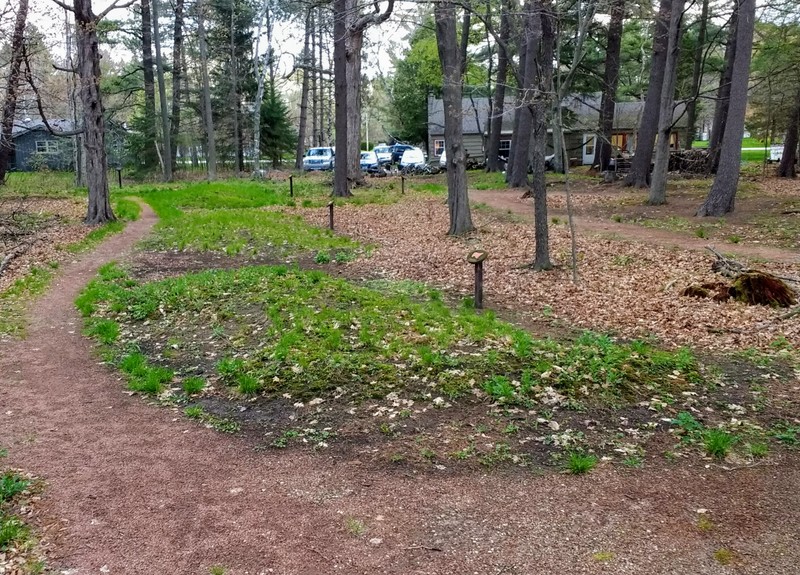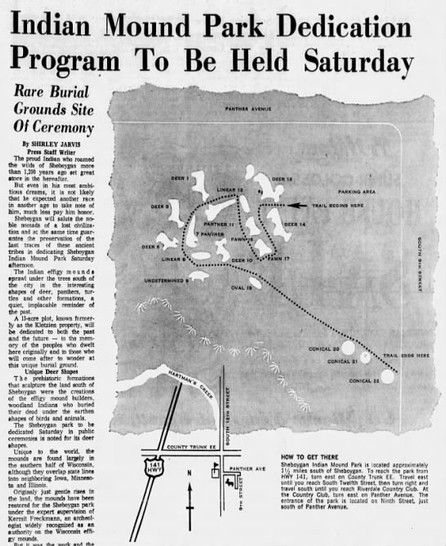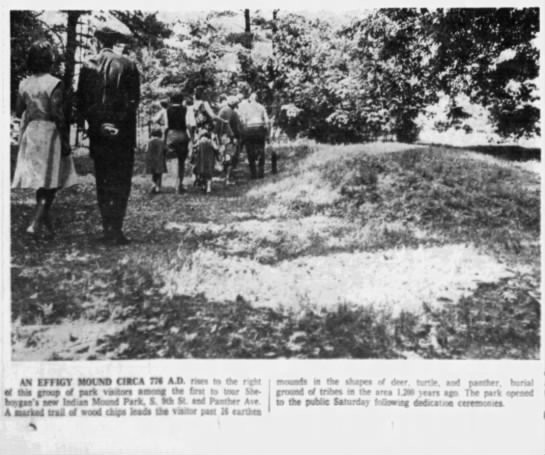Sheboygan Indian Mound Park
Introduction
Text-to-speech Audio
This 15-acre area was dedicated as a city park on June 26, 1966. It was placed on the National Register of Historic Places fifteen years later. The park features effigy mounds of various shapes built by the Late Woodland peoples of Wisconsin, and are considered sacred spaces. The current mounds are largely rebuilt after a Milwaukee Public Museum excavation of the original mounds in 1927.
Images
Fawn Mound in the summer



Backstory and Context
Text-to-speech Audio
The Late Woodland peoples who called Wisconsin home between 1000 and 2000 years ago established a tradition of building large earthen mounds in various shapes. Mounds that are shaped like animals, spirits, or other creatures are called effigy mounds. Today, effigy mounds can still be found throughout southern Wisconsin, including in Sheboygan County. In fact, Wisconsin has more effigy mounds than any other place in North America.
Some earthen mounds are cone shaped, some are linear, and some are shaped like creatures. Effigy mounds throughout Wisconsin represent animals and spirits of the air, earth, and water. The mounds were meticulously planned, and their construction required cooperation from many people. In some cases, construction spanned decades or several generations. The shapes were laid out in alignment with the surrounding landscape, with other existing mounds, and in some instances, with complex astronomical and natural phenomena such as true north, the solstice, the equinox, and constellations. The language, science, and cultural and spiritual significance of the mounds is still being revealed.
Sheboygan Indian Mound Park’s mound group consists of an arrangement of deer, fawn, panther, oval, linear, and conical mounds. The land formations nearby made this site a suitable place for mound construction. Notice the placement of the mounds--clustered together on flat land, high above the creek and the springs that feed it. Mounds were often built near water and in places where high land meets low wetland or other bodies of water. These places, halfway between the earth and sky, held special religious and ceremonial significance.
Once the mound’s layout was arranged, the builders dug the top layer of the surrounding earth, which they carried in handmade baskets and then added to the mound. Portions of some mounds were formed from special soil carried from miles away.
Many effigy mounds--perhaps as high as 95%--were used as graves to honor and bury the dead, but that was not their only purpose. Because the Mound Builders left no documentation about their process or intentions, the information we have primarily comes from two sources. One source is the many artifacts found within or near the mounds. The other is knowledge based on oral traditions of modern nations such as the Ho-Chunk people, who are descended from some of the long-ago Mound Builders. For instance, the Ho-Chunk idea of a long-tailed water spirit informs our modern idea of the Panther mounds you see here.
In addition to being burial sites, the mounds were places of community and ceremony. They were gathering places for small family groups to come together with their larger clan or tribal group for certain parts of the year. The shapes of the effigy mounds were also a way to honor nature and the beliefs of the Mound Builders.
Eventually, Woodland people stopped building mounds in Wisconsin. But the mounds that remain are sacred sites for the descendants of the people who built them, and a treasure from the past for all of humanity to respect and learn from.
The majority of mounds in Sheboygan County were destroyed by farming and road construction between 1860 and 1950. Within the City of Sheboygan, mounds are documented to have existed near the south end of Wildwood Avenue, at the east end of Union Avenue, and on the site of Vollrath Park. Mounds were also formally documented in Sheboygan Falls and in the Towns of Holland, Lima, Rhine, Russell, Scott, and Mitchell. The site of Sheboygan’s Indian Mound Park was rescued from subdivision development through the educational and fundraising efforts of nine local garden clubs, led by the Juniper Garden Club. The 15-acre area was dedicated as a city park on June 26, 1966, and placed on the National Register of Historic Places fifteen years later. Also, in 1981, a nature trail leading down to Hartman Creek was dedicated and to this day remains a project of the Town and Country Garden Club.
The mounds you see today are largely rebuilt after centuries of weathering as well as an excavation project carried out by the Milwaukee Public Museum in 1927. It is now illegal to dig inside effigy mounds, since a state law protecting them passed in 1986. Just like other graveyards or cemeteries, mounds and mound groups are protected spaces and should be respected. Most mound sites have signs reminding visitors not to walk on the mounds. This is not only to show respect, but also to help preserve the mounds for the future.
Sources
Sheboygan Indian Mound County Park, Wisconsin First Nations. Accessed October 16th, 2023. https://wisconsinfirstnations.org/sheboygan-indian-mound-county-park/.
Dippel, Beth. "History Uncovered: Sheboygan County Indian Mounds." Sheboygan Sun (Sheboygan) August 10th, 2022.
Sheboygan Indian Mound Park, Wisconsin Historical Society. Accessed October 16th, 2023. https://www.wisconsinhistory.org/Records/Article/CS12900.
